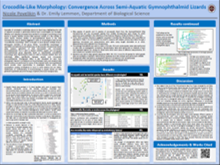President's Showcase
Nicole Povelikin She/Her/Hers
Supervising Professor: Dr. Emily Lemmon
Nicole is a second year Biology major focusing on ecology and evolution, hoping to pursue a career in scientific research at a museum. Her research concentrates on herpetofauna, but is more broadly motivated by theoretical questions surrounding adaptation, reticulate evolution, biological invasions, and phenotypic plasticity. She began researching Gymnophthalmid lizards in high school while studying morphological variation in the genus Neusticurus. Her Idea Grant research allowed her to return to NYC this summer and pursue questions on convergent evolution in semi-aquatic Gymnophthalmid lizards which emerged through her research in high school.
Abstract
Examples of convergent morphology abound in lizard taxa, highlighting the role of adaptive processes in generating diverse lizard morphologies and ecologies. Whether such adaptive processes have resulted in convergent morphology across lizards in aquatic habitats remains little explored outside of a few studies on Anolis lizards. Previous studies of Gymnophthalmid lizards in the tribe Cercosaurinae have in passing suggested a suite of morphological traits termed “crocodile-like morphology,” which is thought to have evolved multiple times in semi-aquatic members of the group. Herein, "crocodile-like morphology" is quantified and explored across several taxa of semi-aquatic Cercosaurinae lizards using museum specimens of both semi-aquatic and non-aquatic members of the clade. PCA is used to explore whether aquatic and non-aquatic Gymnophthalmids group separately based on hypothesized crocodile-like morphology traits. Randomization tests are used to evaluate whether each trait individually differs significantly between semi-aquatic and non-aquatic Gymnophthalmids. This system provides novel opportunities to investigate factors which drive convergence, causing convergence to occur in some systems but not others. Additionally, an understanding of ecomorphology in aquatic lizards can help generate hypotheses about the ecology of species which lack ecological data.



